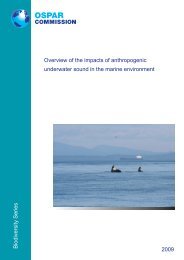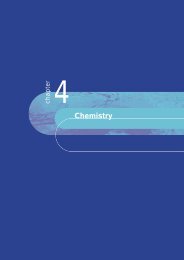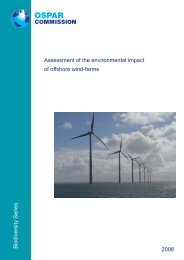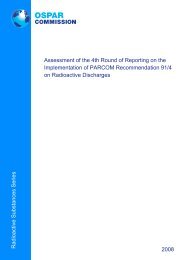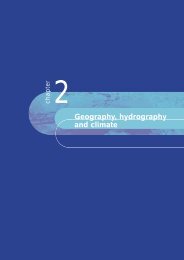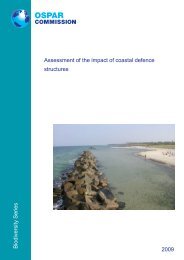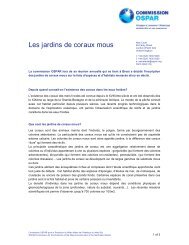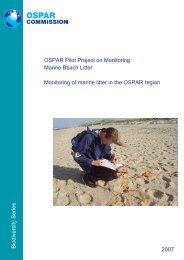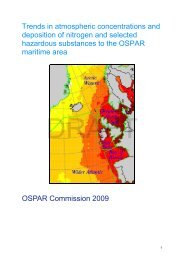2009 - OSPAR Commission
2009 - OSPAR Commission
2009 - OSPAR Commission
You also want an ePaper? Increase the reach of your titles
YUMPU automatically turns print PDFs into web optimized ePapers that Google loves.
Hazardous Substances Series<br />
Background Document on<br />
short chain chlorinated paraffins<br />
<strong>2009</strong>
Background Document on Short Chain Chlorinated Paraffins<br />
<strong>OSPAR</strong> Convention<br />
The Convention for the Protection of the<br />
Marine Environment of the North-East Atlantic<br />
(the “<strong>OSPAR</strong> Convention”) was opened for<br />
signature at the Ministerial Meeting of the<br />
former Oslo and Paris <strong>Commission</strong>s in Paris<br />
on 22 September 1992. The Convention<br />
entered into force on 25 March 1998. It has<br />
been ratified by Belgium, Denmark, Finland,<br />
France, Germany, Iceland, Ireland,<br />
Luxembourg, Netherlands, Norway, Portugal,<br />
Sweden, Switzerland and the United Kingdom<br />
and approved by the European Community<br />
and Spain.<br />
Acknowledgement<br />
2<br />
Convention <strong>OSPAR</strong><br />
This report has been prepared by Mr Bo Nyström for Sweden as lead country<br />
La Convention pour la protection du milieu<br />
marin de l'Atlantique du Nord-Est, dite<br />
Convention <strong>OSPAR</strong>, a été ouverte à la<br />
signature à la réunion ministérielle des<br />
anciennes <strong>Commission</strong>s d'Oslo et de Paris,<br />
à Paris le 22 septembre 1992. La Convention<br />
est entrée en vigueur le 25 mars 1998.<br />
La Convention a été ratifiée par l'Allemagne,<br />
la Belgique, le Danemark, la Finlande,<br />
la France, l’Irlande, l’Islande, le Luxembourg,<br />
la Norvège, les Pays-Bas, le Portugal,<br />
le Royaume-Uni de Grande Bretagne<br />
et d’Irlande du Nord, la Suède et la Suisse<br />
et approuvée par la Communauté européenne<br />
et l’Espagne.<br />
Secretariat note: This Background Document was prepared by Sweden as lead country and first<br />
adopted in 2001. A monitoring strategy for lead was added in 2004 (annex 1). The document was<br />
updated in <strong>2009</strong>.
<strong>OSPAR</strong> <strong>Commission</strong>, <strong>2009</strong><br />
Executive Summary .......................................................................................................... 4<br />
Récapitulatif ....................................................................................................................... 4<br />
1. Introduction ............................................................................................................. 6<br />
2. Sources of Short Chain Chlorinated Paraffins and their pathways to the<br />
marine environment .......................................................................................................... 7<br />
2.1 Production and use in the European Community ........................................... 7<br />
2.2 Emissions and discharges .............................................................................. 8<br />
2.3 Pathways to the Marine Environment ............................................................. 8<br />
3. Monitoring data, quantification of sources and assessment of the<br />
extent of problems ............................................................................................................ 9<br />
3.1 Monitoring data ............................................................................................... 9<br />
3.1.1 Conclusion of comparison of the monitoring data found before<br />
and after 2001............................................................................................... 12<br />
3.2 Quantification of sources .............................................................................. 12<br />
3.2.1 Releases to the environment ............................................................. 12<br />
3.2.2 Human exposure ................................................................................ 13<br />
3.3 Assessment of the extent of problems ......................................................... 13<br />
4. Desired reduction ................................................................................................. 14<br />
5. Identification of measures ................................................................................... 14<br />
5.1 Measures within the European Community .................................................. 14<br />
5.2 Implementation of PARCOM Decision 95/1 by Contracting Parties ............. 15<br />
5.3 Alternatives to short chain chlorinated paraffins ........................................... 15<br />
5.4 Identification of possible <strong>OSPAR</strong> measures ................................................. 16<br />
6. Choice for action ................................................................................................... 16<br />
References ....................................................................................................................... 18<br />
Annex 1: Monitoring strategy for short chained chlorinted paraffins ....................... 20<br />
3
Background Document on Short Chain Chlorinated Paraffins<br />
Executive summary<br />
Short-chain chlorinated paraffins (SCCPs) are n-paraffins that have a carbon chain length of between<br />
(and including) 10 and 13 carbon atoms and a degree of chlorination of more than 48% by weight.<br />
They are very persistent and not biodegradable. They adsorb strongly to sludge and sediments. They<br />
are therefore very likely to bioaccumulate. They are carcinogenic. The <strong>OSPAR</strong> Action Plan in 1992<br />
gave priority to action on them, and they were therefore included in the List of Chemicals for Priority<br />
Action in 1998.<br />
SCCPs are mainly used as metal-working fluids, with other major uses being in paints, coatings and<br />
sealants and as flame-retardants in rubber and textiles. The main sources of inputs to the sea are<br />
therefore production sites for SCCPs and products containing them and metal-, leather- and rubberworking-sites<br />
where they are used.<br />
Releases of EU-produced SCCPs from EU sites to water in 1994 were estimated at 1784 tonnes a<br />
year, 95% of which was from metal-working sites. Substantial reductions in use have since been<br />
made. There are, however, no figures for releases from products or from imported SCCPs.<br />
Concentrations of SCCPs of 426 – 526 μg/kg have been found in Arctic marine mammals.<br />
The existing <strong>OSPAR</strong> measure is PARCOM Decision 95/1, which required the phasing-out by the end<br />
of 1999 of the use of SCCPs as plasticisers in paints and coatings, as plasticisers in sealants, in<br />
metal-working fluids and as flame retardants in rubber, plastics and textiles, except for some uses in<br />
dams and mining where the end-date was the end of 2004. EC Directive 2002/45/EC bans the use in<br />
metal-working fluids, and leather finishing. SCCPs are identified as priority hazardous substances<br />
under the EC Water Framework Directive.<br />
The action proposed is: greater efforts to implement PARCOM Decision 95/1, including identifying<br />
uses not previously recognised, identification of acceptable alternatives, and avoidance of the use of<br />
unacceptable substitutes; to review by <strong>OSPAR</strong> of the need for further <strong>OSPAR</strong> measures to<br />
supplement the EC measures; and to ask other relevant international forums to take account of the<br />
Background Document.<br />
Récapitulatif<br />
Les paraffines chlorées à chaîne moléculaire courte (SCCP) sont des paraffines « n » dont la chaîne<br />
de carbone comporte entre 10 et 13 atomes de carbone (inclus) et possédant un degré de chloration<br />
de plus de 48% de leur poids. Elles sont très persistantes et ne sont pas biodégradables. Elles sont<br />
fortement adsorbées sur la boue et les sédiments. Elles ont donc de fortes chances de s’accumuler<br />
biologiquement. Elles sont cancérigènes. Une action prioritaire à leur égard est prévue dans le Plan<br />
d’action <strong>OSPAR</strong> 1992, d’où le fait qu’en 1998, elles aient été inscrites sur la Liste des produits<br />
chimiques devant faire l’objet de mesures prioritaires.<br />
Les SCCP sont pour l’essentiel utilisées comme fluides de travail des métaux, leurs principales autres<br />
applications étant dans les peintures, les revêtements et les produits d’étanchéité, ainsi que comme<br />
agents ignifuges dans le caoutchouc et les textiles. Les principales sources d’apport à la mer sont<br />
donc constituées par les sites de fabrication des SCCP ainsi que par les produits qui en contiennent,<br />
de même que par les sites de transformation des métaux, du cuir et du caoutchouc où elles sont<br />
utilisées.<br />
Les émissions dans l’eau de SCCP fabriquées dans l’Union européenne et provenant de sites se<br />
trouvant dans l’Union européenne ont été estimées en 1994 à 1784 tonnes par an, dont 95%<br />
4
<strong>OSPAR</strong> <strong>Commission</strong>, <strong>2009</strong><br />
provenaient de sites de travail des métaux. Depuis lors, d’importantes réductions ont été obtenues<br />
dans leur consommation. Il n’existe cependant aucune statistique des émissions dues aux produits ni<br />
des importations de SCCP. Des teneurs en SCCP se situant entre 426 et 526 µg/kg ont été<br />
constatées chez des mammifères marins de l’Arctique.<br />
La mesure <strong>OSPAR</strong> en vigueur est la décision PARCOM 95 /1, qui exige l’abandon, d’ici la fin de 1999,<br />
de l’utilisation des SCCP comme plastifiants dans les peintures et les revêtements, comme plastifiants<br />
dans les produits d’étanchéité, dans les fluides de travail des métaux et comme agent ignifuge dans le<br />
caoutchouc, les matières plastiques et les textiles, excepté dans le cas de certaines applications dans<br />
les barrages et les mines, où la date limite d’abandon a été fixée à fin 2004. La Directive<br />
communautaire européenne 2002/45/EC interdit son utilisation dans les fluides de travail de métaux et<br />
dans la finition des cuirs. Les SCCP sont définies comme des substances dangereuses prioritaires<br />
dans le cadre de la Directive communautaire européenne cadre relative aux eaux.<br />
L’action proposée est la suivante : intensification des efforts de mise en œuvre de la Décision<br />
PARCOM 95/1, dont l’identification des applications qui n’ont pas encore été décelées, la<br />
détermination d’alternatives acceptables, et la non-utilisation de succédanés inacceptables ; examen<br />
par <strong>OSPAR</strong> de la question de savoir si de nouvelles mesures <strong>OSPAR</strong> venant compléter les mesures<br />
communautaires européennes éventuelles s’imposent ; et enfin, demande adressée aux autres<br />
instances internationales compétentes de prendre en considération le document de fond<br />
correspondant.<br />
5
Background Document on Short Chain Chlorinated Paraffins<br />
1. Introduction<br />
In PARCOM Decision 95/1 on the Phasing Out of Short Chained Chlorinated Paraffins, Contracting<br />
Parties agreed (with reservations from Portugal 1 and the United Kingdom 1 ) on the phasing out of short<br />
chained, highly chlorinated paraffins. “Chlorinated paraffins” are here defined as mixtures of<br />
compounds that are manufactured by the chlorination of n-paraffins with carbon chain length between<br />
and including 10 and 36 and with a chlorination degree between 10 and 72% by weight. Short chain<br />
chlorinated paraffins (SCCPs) are defined as chlorinated paraffins with carbon chain length between<br />
and including 10 and 13 and with a chlorination degree of more than 48% by weight.<br />
Occurrences of SCCPs, in particular those with carbon chain length C10-C13 and a chlorination of<br />
>50% were found in the aquatic environment of industrial and non-industrial areas as well as in<br />
aquatic and terrestrial organisms, were reasons for concern. Further justifications for PARCOM<br />
Decision 95/1 were the persistent and bioaccumulative properties of these substances, together with<br />
their toxicity to aquatic organisms and carcinogenicity to rats and mice. It was considered that less<br />
environmentally hazardous substitutes were available for most major applications.<br />
SCCPs are also on the <strong>OSPAR</strong> List of Chemicals for Priority Action (Agreement 2004-12).<br />
The following substance information is given in the risk assessment within the framework of the<br />
European Union (EU) Existing Substances Regulation (EEC) 793/93/EEC, for ‘typical’ C10-13<br />
chloroalkanes (short chain length chlorinated paraffins) (EU, 2008):<br />
6<br />
CAS No 85535-84-8<br />
Molecular formula CxH(2x-y+2)Cly, where x = 10 to 13 and y = 1 to x<br />
Synonyms Alkanes, chlorinated; alkanes (C10-13), chloro-(50 - 70%); alkanes (C10-<br />
12), chloro-(60%); chlorinated alkanes; chlorinated paraffins;<br />
chloroalkanes; chlorocarbons; polychlorinated alkanes; paraffinschlorinated.<br />
SCCPs occur in industrial formulations as highly complex mixtures, which make the chemical analysis<br />
complicated. The calibration is a major problem, yielding hugely variable results, and there are no<br />
certified reference materials (CRMs) available. In order to get comparable results in a one-off survey it<br />
is therefore essential that all analyses will be undertaken at one laboratory. In addition, SCCPs is a<br />
priority group within the EU Water Framework Directive, so further method development is likely to<br />
occur (ICES, 2004).<br />
The EU risk assessment for SCCPs was first published in October 1999 and updated in 2008.<br />
Environmental risks of SCCP were identified for the aquatic environment where e.g. metalworking and<br />
fat liquoring for leather takes place. An EC Directive restricting the use of SCCPs was published in<br />
2002 (Directive 2002/45/EC). SCCPs are classified as dangerous for the environment (very toxic to<br />
aquatic organisms) (Technical channels, 2004). In March 2003 an updated environmental risk<br />
assessment report was published, which included new data. This report identified a number of<br />
potential risks of SCCPs in several environmental compartments, and it was recommended that further<br />
exposure information should be gathered (Technical channels, 2004).<br />
1 Portugal lifted its reservations at <strong>OSPAR</strong>/MMC 1998. The UK entered its reservation to this Decision<br />
because it considered that the competence to enforce it rests with the European Community. The UK<br />
urges the European <strong>Commission</strong> to bring forward early proposals on that subject.
<strong>OSPAR</strong> <strong>Commission</strong>, <strong>2009</strong><br />
2. Sources of Short Chain Chlorinated Paraffins<br />
and their pathways to the marine environment<br />
2.1 Production and use in the European Community<br />
According to the EU risk assessment, C10-13 chloroalkanes were manufactured by two producers within<br />
the European Union (EU), and with a total production of < 15 000 tonnes/year (1994). The main uses<br />
were in metal working fluids, as plasticiser in paints, coatings and sealants, as flame retardant in<br />
rubbers and textiles, and in leather processing (fat liquoring).<br />
Recent data shows that the corresponding use of SCCPs has been reduced from 13 000 tonnes in<br />
1994 to 4000 tonnes in 1998 (Chlorinated Paraffins Sector Group of CEFIC, 1999; Table 1 below).<br />
The main use in 1998 was still in metal working fluids, in spite of a considerable reduction of<br />
7362 tonnes. The different uses in products mentioned in PARCOM Decision 95/1 have also declined<br />
considerably. Overall there has been a reduction of nearly 70% over the period 1994 to 1998, largely<br />
due to voluntarily agreements by industry.<br />
The unspecified group “other” increased considerably from 100 tonnes in 1994 to 648 tonnes in 1998.<br />
However, this category may have been used to categorise tonnage where manufacturers are not sure<br />
of the exact uses further down the supply chain, and/or to render an account for some earlier not<br />
known uses. Therefore, an increase in other uses does not necessarily mean that these are different<br />
from those already identified. It could also be a difference in the basis for reporting between 1994 and<br />
1998. On the other hand, it is not possible to rule out new product developments using SCCPs.<br />
In 1998, about 50% of European sales and about 10% each of Medium Chain Chlorinated Paraffins<br />
(MCCPs) and Long Chain Chlorinated Paraffins (LCCPs) sales have been used for formulation of<br />
metal working fluids.<br />
Table 1: Use of SCCPs in Europe, tonnes per year and per cent of total<br />
Application tonnes/year in 1994 tonnes/year in 1998<br />
Metal working fluids 9380(71.02%) 2018(49.5%)<br />
Paints, coatings and sealants 1150(8.71%) +<br />
695(5.26%) ++<br />
726(17.8%) +++<br />
Rubber/flame retardants/ 1310(9.91%) 638(15.7%)<br />
Leather fat liquors 390(2.95%) 45(1.1%)<br />
Textile/polymers (other than PVC) 183(1.4%)<br />
PVC plasticisers - -<br />
Other 100(0.75%) 648(15.9%)<br />
Total 13208 4075<br />
There is no specific information on the use category “Other”.<br />
+ figures for paints; ++ figures for coatings and sealants; +++ figures for paints, coatings and sealants<br />
It has not, within the scope of this document, been possible to obtain information on the amount of<br />
SCCPs imported into the European Community. Hence, it has not been possible to estimate use<br />
categories for imported SCCPs. Neither has it been possible to get any figures on the amounts of<br />
SCCPs entering the EU through imported goods. According to a recent report (1999), the total<br />
production of SCCPs, MCCPs and LCCPs in China in 1997 was about 100 000 tonnes. Even if only a<br />
7
Background Document on Short Chain Chlorinated Paraffins<br />
very small fraction reaches the EU, e.g. through imported goods, it can still represent significant<br />
amounts.<br />
The EU’s ban of SCCPs for metal and leather working was applied in January 2004. The usage of<br />
SCCPs in 1994 in products was in Sweden reported to be 233 tonnes in about 50 products. In 2005<br />
the usage had decreased to 14 tonnes in 18 products (Kemi-Stat, 2008). In France, several thousands<br />
of tonnes were used in the beginning of the 1990s but only 222 tons in 2002. At the time 147 tonnes<br />
were still used for metal working fluid, which was expected to end in 2004 (INERIS, 2005).<br />
2.2 Emissions and discharges<br />
The main sources, identified in the EU risk assessment as having the potential for releases to water,<br />
sediment and sewage sludge are production sites for SCCPs, production sites for the formulation of<br />
metal working fluids and leather finishing agents, as well as metal working and leather finishing plants.<br />
Metal working plants are also sources for releases to landfills, like leather finishing plants are to air.<br />
Rubber working plants are emitting to water, air and soil. Of these, the use of metal working fluids is<br />
still by far the largest source of releases into the environment.<br />
As considered in PARCOM Decision 95/1, different products, e.g. articles, containing SCCPs are also<br />
potential sources of emissions. This can be the case during production and use, and when the articles<br />
become waste and are sent to landfill. SCCPs could be a possible source of PCBs (polychlorinated<br />
biphenyls) and PCNs (polychlorinated naphthalenes) formation via incineration of wastes.<br />
In the EU risk assessment, emissions from articles are discussed very briefly. Elaborated methods to<br />
estimate this are lacking in the EC Technical Guidance Document (TGD) on Risk Assessment of New<br />
and Existing Substances (1996). However, reported data on emissions from surfaces with a paint<br />
containing SCCPs could indicate that such emissions can be significant.<br />
The emissions of SCCPs in Europe 2001 reported to the European Pollutant Emission Register<br />
(EPER) are given in Table 2. The emissions of SCCPs mainly take place indirect to water, via transfer<br />
to an off site water treatment plant.<br />
Table 2. Total emissions in Europe of SCCPs reported to EPER 2001 in tonnes (EPER 2006)<br />
8<br />
Activity To air<br />
(per year)<br />
Direct to<br />
water<br />
(per year)<br />
Indirect to water<br />
(transfer to off-site waste<br />
water treatment)<br />
Combustion installations<br />
> 50 MW<br />
- - 0.0022<br />
Basic organic chemicals - - 0.01584<br />
Basic inorganic<br />
chemicals or fertilisers<br />
- 0.01 -<br />
Total - 0.01 0.01804<br />
2.3 Pathways to the marine environment<br />
If SCCPs reach the marine environment, they will generally do so via rivers and via the atmosphere,<br />
from the main compartments to which releases occur. The latter are sediment and surface waters in<br />
rivers, lakes and seas, air, and soil spread with sewage sludge. Furthermore, recent reports of high<br />
levels of SCCPs in biological samples from the Arctic could indicate that these chemicals are<br />
effectively transported over long distances.
<strong>OSPAR</strong> <strong>Commission</strong>, <strong>2009</strong><br />
3. Monitoring data, quantification of sources and<br />
assessment of the extent of problems<br />
3.1 Monitoring data<br />
Concentrations of SCCPs in surface water, sediment, sewage sludge up to 2001<br />
Monitoring data from the EU Risk Assessment Report (1999) and from Organohalogen Compounds,<br />
Volume 47 (2000) are summarised here:<br />
Levels of 0.12 - 1.45 µg/l have been measured in surface water in rivers from industrial areas in the<br />
United Kingdom in the year 1986;<br />
Levels of 0.50 - 1.2 µg/l and 0.05 - 0.12 µg/l have been measured in two rivers in Germany<br />
in the years 1987 and 1994, respectively. These values include sites downstream from a<br />
chlorinated paraffins production plant;<br />
Levels of 17 - 83 µg/kg dry weight in sediments have been measured in rivers in Germany<br />
in 1994. These values also includes sites downstream from a chlorinated paraffins<br />
production plant;<br />
Levels of 47 - 65 µg/g in sewage sludge have been measured near a metal working plant in<br />
Germany. Further levels around 0.12 µg/l in the run-off water from the sewage plant into a<br />
nearby river, and of 0.08 and 0.07 µg/l in the river water, up and downstream from the metal<br />
working plant have been measured in the years 1991 to 1993;<br />
Levels of 18 - 275 µg/kg dry weight in surface sediments have been measured in three<br />
lakes in Canada;<br />
Levels of 0.0073 - 0.29 µg/g in surface sediment have been measured in harbour areas<br />
along Lake Ontario;<br />
Average levels around 1.8 µg/g have been measured in sediment of the Detroit River at<br />
Lake Eire in Canada;<br />
Levels of 0.06 - 0.448 µg/l have been measured in final effluent from sewage treatment<br />
plants in southern Ontario in Canada in 1998;<br />
Levels of around 0.0045 g/g dry weight have been measured in sediment in Lake Hazen<br />
on Ellesmere Island in the Arctic;<br />
Estimates of SCCPs in waters in non-industrial areas compared to marine waters and<br />
industrial areas in the United Kingdom were 0.1 - 0.3, 0.1 - 1 and 0.1 - 2 µg/l, respectively.<br />
These data were estimated from analytical values for all chlorinated paraffins in the range<br />
C10-C20 (data published in 1980).<br />
Monitoring data of SCCPs in sediments, water, digested sludge and soil published after 2001<br />
In general, Baltic Sea sediments were more contaminated with Chloroparaffins (CPs) than<br />
North Sea sediments. The concentrations of SCCPs in sediments from the North Sea<br />
varied between 5 to 112 ng/g dw and in sediments from the Baltic Sea between 116 to<br />
377 ng/g dw. The samples were collected between August 2001 and May 2003 (Huttig and<br />
Oehme, 2005);<br />
The concentrations of SCCPs in surface sediments collected during 1998 in Lake Ontario<br />
in North America were on average 49 ng/g dw with the highest concentrations ranging from<br />
9
Background Document on Short Chain Chlorinated Paraffins<br />
10<br />
147 to 410 ng/g dw (Marvin et al. 2003). The highest concentrations were found in the most<br />
industrialised areas. Core samples from a polluted site in the Niagara Basin showed a<br />
decreasing trend of accumulation of SCCPs with the highest peak during the 1970s of<br />
about 700 - 800 ng/g dw. However at a background site in Lake Ontario there was still a<br />
slight increase in accumulation of SCCPs (Marvin et al. 2003);<br />
SCCP and MCCP (medium chain chlorinated paraffins) in samples from the UNITED<br />
KINGDOM collected 1983 to 1988 showed concentration levels in sediment of
<strong>OSPAR</strong> <strong>Commission</strong>, <strong>2009</strong><br />
Concentrations of chlorinated paraffins (C6-C16, C10-C20 and C15-C17 respectively) in biota up to<br />
2001<br />
On a lipid basis, levels of around 1500 µg/kg chlorinated paraffins (C6-C16) have been<br />
measured in herring (muscle), in the Bothnian Sea, in the Baltic Sea and in Skagerrak in<br />
Sweden in the years 1986 and 1987;<br />
High concentrations of chlorinated paraffins (C6-C16) have also been measured in rabbit and<br />
moose (2900 and 4400 µg/kg, respectively on a lipid basis) in Sweden in 1986;<br />
On a lipid basis, levels of around 130 and 280 µg/kg chlorinated paraffins (C6-C16),<br />
respectively, have been measured in ringed seal blubber from Kongsfjorden, Svalbard in<br />
1981 and in grey seal blubber from the Baltic Sea during 1979 - 85;<br />
On a lipid basis, levels of chlorinated paraffins (C6-C16) of around 1000 µg/kg and<br />
570 µg/kg, respectively, have been measured in whitefish muscle in Lake Storvindeln,<br />
Lapland, in Sweden and in Arctic char muscle in Lake Vättern, central Sweden in 1986 and<br />
1987;<br />
On a lipid basis, levels of chlorinated paraffins (C6-C16) of around 140 µg/kg and 530 µg/kg,<br />
respectively, have been measured in reindeer suet and in osprey muscle in Sweden in<br />
1986;<br />
Levels of chlorinated paraffins (C10-C20) up to 200 µg/kg in fish, 100 - 12 000 µg/kg in<br />
mussels, levels in mussels above 200 g/kg have been measured in the Wyre Estuary<br />
close to a paraffinic production site, 50 - 2000 g/kg have been found in seabirds (eggs),<br />
100 - 1200 g/kg in heron and guillemot, 200 - 900 g/kg in herring gull, 50 - 200 g/kg in<br />
sheep close to a chlorinated paraffin production plant and 40 - 100 g/kg in grey seal have<br />
been found in the United Kingdom (data published in year 1980). All these values were<br />
estimated from analytical values for all chlorinated paraffins in the range C10 to C20;<br />
Stern et al. (1998) noted that the Arctic formula group profiles showed higher proportions of<br />
the lower chlorinated congeners (Cl5-Cl7), suggesting that the major source of contamination<br />
to the Arctic is via long range atmospheric transport.<br />
Monitoring data of SCCPs in Biota published after 2001<br />
In liver samples of little aUnited Kingdoms collected in the European Arctic SCCP levels of<br />
5 - 88 ng/g ww were found (Reth et al. 2006). The range for SCCPs in cod varied from 11 to<br />
70 ng/g ww, and in Arctic char from 7 to 27 ng/g ww;<br />
Fish from the North Sea and the Baltic Sea were collected during 2002; cod, flounder and<br />
North Sea dab. In the Baltic Sea the concentration levels of SCCPs varied between 19 and<br />
221 ng/g ww, and in the North Sea the levels varied between 26 and 286 ng/g ww. The<br />
congener patterns in the samples from the Baltic Sea were similar to commercial SCCP<br />
mixtures and C13 were the most abundant, while the North Sea samples had a higher<br />
abundance of C10 (Reth et al. 2005);<br />
In ringed seals from Pangnirtung and Eureka in the Canadian Arctic, levels of SCCP of 95<br />
and 527 ng/g ww were found, respectively (Braune et al. 2005);<br />
The concentrations of SCCP and MCCP in biota samples collected during 1983 to 1988 in<br />
UNITED KINGDOM were in fish
Background Document on Short Chain Chlorinated Paraffins<br />
12<br />
Moose liver and muscle samples from Sweden, Norway and Finland collected in the late<br />
1990s showed levels below the detection limit, < 20 ng/g fresh muscle tissue (Fridén et al.<br />
2004);<br />
SCCPs have recently been found in Arctic biota but there is still insufficient information to<br />
assess species differences, spatial patterns or food web patterns (Braune et al. 2005). The<br />
SCCPs are found in fish samples from the North Sea and the Baltic Sea, at concentrations<br />
up to 300 ng/g wet weight in dab liver (North Sea), and in cod liver at up to 100 ng/g (North<br />
Sea) and 150 ng/g (Baltic) (ICES 2004);<br />
Blue mussel from Norway showed a concentration range from 0.9 to 4.8 ng/g ww. Samples<br />
from Bölmo/Sotra had a concentration of 4.8 ng/g ww and samples from Ulleröy/Lista had a<br />
concentration of 0.9 ng/g ww (Fjeld et al. 2004);<br />
Cod liver from Norway had concentrations of SCCPs between 30 ng/g ww in<br />
Drammensfjorden to 110 ng/g ww in Ulleröy/Lista area (Fjeld et al. 2004);<br />
Concentrations of chlorinated paraffins (C10-C30) in household waste;<br />
Levels of 0.5 - 48 g/g dry matter of chlorinated paraffins (C10-C30) have been measured in<br />
household waste collected from the Uppsala municipality in Sweden in 1995.<br />
3.1.1 Conclusion of comparison of the monitoring data found before and after 2001<br />
No general decrease in the concentration levels of SCCPs in sediments and biota in the samples<br />
collected and reported lately were found when compared to data published before 2001.<br />
3.2 Quantification of sources<br />
3.2.1 Releases to the environment<br />
The EU Existing Substances Regulation risk assessment (EU, 2008) concluded that risk reduction in<br />
metal working would eliminate 98% of the total environmental burden. This risk assessment, carried<br />
out by the United Kingdom, contains a number of release estimates, made by using various models<br />
and assumptions. In summary they indicate the following releases of SCCPs in the EU:<br />
0.4 tonnes/year to air, apportioned to rubber formulations
<strong>OSPAR</strong> <strong>Commission</strong>, <strong>2009</strong><br />
3.2.2 Human exposure<br />
In the EU risk assessment, concerns for exposure of workers in metalworking and leather finishing<br />
plants are expressed. It is further concluded that measures identified to protect the environment will<br />
also reduce human exposure.<br />
To date there are no reliable scientific data on exposure to humans/consumers from different products<br />
containing SCCPs. The possibility of emissions from products has, among others, been expressed by<br />
the CSTEE.<br />
A median level of SCCPs in human milk fat was 180 ng/g fat with a range of 49 to 820 ng/g fat in the<br />
UNITED KINGDOM, London and Lancaster (Thomas et al. 2006).<br />
3.3 Assessment of the extent of problems<br />
In the EU risk assessment, it was found that some major characteristics of C10-13 chloroalkanes are<br />
relevant for the assessment of exposure to the environment: the C10-13 chloroalkanes are not<br />
hydrolysed in water; are not readily or inherently biodegradable; have a high log Kow value (4.4 - 8)<br />
and have an estimated atmospheric half-life of 1.9 - 7.2 days. The high log Kow values indicate a high<br />
potential for bioaccumulation, strong adsorption to sludge and sediments and very low mobility in soil.<br />
High bioconcentration factors have been reported with a variety of freshwater and marine organisms<br />
(ranging from 1000 to 50 000 for the whole organism, with high values for individual tissues).<br />
SCCPs have been raised as a concern with regard to long range transport. This is currently being<br />
discussed within the appropriate international forums. High levels of SCCPs in biological samples from<br />
the Arctic indicate that these chemicals are effectively transported over long distances (CSTEE 1998)<br />
and a draft risk profile made for the Stockholm Convention in October 2008 mentions that:<br />
“SCCPs are not expected to degrade significantly by hydrolysis in water, and dated sediment cores<br />
indicate that they persist in sediment longer than 1 year. SCCPs have atmospheric half-lives ranging<br />
from 0.81 to 10.5 days, indicating that they are relatively persistent in air. SCCPs have been detected<br />
in diverse environmental samples (air, sediment, water, wastewater, fish and marine mammals), and<br />
in remote areas such as the Arctic, providing evidence of long-range transport.”<br />
Tumours of the liver, thyroid and kidney (male rats only) were observed in a lifetime carcinogenic<br />
study in rats carried out in the US (Organohalogen Compounds, Volume 47, 2000).<br />
It can be concluded that all environmental contamination of SCCPs is likely to represent a widespread<br />
problem. This is due to the persistent, bioaccumulative and toxic (PBT), as well as the carcinogenic<br />
properties of SCCPs. It can further be concluded that emissions from different, also diffuse sources,<br />
have the potential to reach the maritime area. On the basis of the accessibility of data on the amount<br />
of discharges, emissions and losses from several sources, it is not always possible to fully estimate<br />
the degree of risk to the marine environment. However, the absence of data to quantify emissions<br />
from each source should not be an obstacle to observing potential risks. Hence, the absence of<br />
quantifiable data does not eliminate a risk as such.<br />
13
Background Document on Short Chain Chlorinated Paraffins<br />
4. Desired reduction<br />
The adopted targets for year 2000 and 2004 are outlined in PARCOM Decision 95/1. According to<br />
this, SCCPs should be phased out by 31 December 1999 in metalworking fluids and in major uses as<br />
plasticisers in paints, as coatings and sealants and as flame retardant in rubber, plastics and textiles.<br />
The use as plasticers in sealants in dams, and as flame retardant in rubber in conveyor belts for the<br />
exclusive use in underground mining, should be phased out by 31 December 2004.<br />
The objective for SCCPs, in the framework of the <strong>OSPAR</strong> Strategy on Hazardous Substances, is to<br />
make every endeavour to move towards the target of the cessation of discharges, emissions and<br />
losses of hazardous substances by the year 2020 with the ultimate aim of achieving concentrations in<br />
the marine environment close to zero.<br />
5. Identification of measures<br />
5.1 Measures within the European Community<br />
The C10-13 chloroalkanes are (decision in the 25th Adaptation to Technical Progress of EU Directive<br />
67/548/EEC on the classification, packaging and labelling of dangerous substances) classified as<br />
dangerous for the environment, with the symbol N and the risk phrases R50/53 (very toxic to aquatic<br />
organisms/may cause long-term adverse effects in the aquatic environment) and harmful, carcinogen,<br />
cat. 3 with the symbol Xn and risk phrase R40 (possible risk of irreversible effects).<br />
The agreed conclusions of a final risk assessment and a risk reduction strategy within the framework<br />
of the EU Existing Substances Regulation (EEC) 793/93 were unanimously adopted by Member<br />
States and the <strong>Commission</strong> in July 1999.<br />
The Recommendation of the European <strong>Commission</strong> on a risk reduction strategy for SCCPs was that<br />
limitations on marketing and use within the framework of Council Directive 76/769/EEC for the use and<br />
formulation of products, in particular for metal working and leather finishing, should be considered to<br />
protect the environment. It was further concluded that these measures would reduce concern for<br />
human exposure.<br />
In July 1999 the Directorate General Enterprise of the European <strong>Commission</strong> presented a draft<br />
proposal on limitations on marketing and use of metalworking fluids and leather finishing uses of<br />
SCCPs. Member States were divided on this proposal in the light of PARCOM Decision 95/1. The<br />
Directive 2002/45/EC later prohibited the use of SCCPs in substances and preparations for<br />
metalworking fluids and for fat liquoring of leather in concentrations higher than 1%. In the Directive it<br />
was stated that a review should be made before 1 January 2003 of new relevant scientific data,<br />
especially on emissions. In a recital introducing the articles, references are made to those products<br />
included in PARCOM Decision 95/1. This review was made, but no further measures have been<br />
proposed. SCCPs have however been selected as a Substance of Very High Concern (SVHC) based<br />
on its PBT properties and further use in the EU will require authorisation.<br />
In the framework of Directive 2000/60/EC of the European Parliament and of the Council of<br />
establishing a framework for Community action in the field of water policy (Water Framework Directive)<br />
the Council has reached on 7 June 2001 a common position on the establishment of a list of priority<br />
substances, including substances identified as priority hazardous substances. C10-13 chloroalkanes are<br />
included in this list with an indication that they are identified as priority hazardous substances. With<br />
respect to the priority substances, the European <strong>Commission</strong> shall submit proposals of controls for the<br />
14
<strong>OSPAR</strong> <strong>Commission</strong>, <strong>2009</strong><br />
progressive reduction of discharges, emissions and losses of substances concerned, and, in particular<br />
the cessation or phasing out of discharges, emissions and losses of priority hazardous substances.<br />
Hazardous substances are defined in the Water Framework Directive as “substances or groups of<br />
substances that are toxic, persistent and liable to bio-accumulate, and other substances or groups of<br />
substances which give rise to an equivalent level of concern”. In drawing up the above list, the<br />
European <strong>Commission</strong> has taken into account <strong>OSPAR</strong> work on the prioritisation of hazardous<br />
substances.<br />
The European Union has also notified SCCPs to the Stockholm POPs convention and a draft risk<br />
profile has been prepared (UNEP, 2008).<br />
5.2 Implementation of PARCOM Decision 95/1 by Contracting Parties<br />
Sweden made a review of the status of implementation by Contracting Parties of PARCOM Decision<br />
95/1 in 2006 (Insert publication number). The review notes the coming into force of the EU directive<br />
2002/45/EC. In the conclusion it is also stated that:<br />
“<strong>OSPAR</strong> should cooperate with the <strong>Commission</strong> to perform the envisaged overview of the remaining<br />
uses of SCCPs that might give reasons for concern for the marine environment and future EC risk<br />
reduction measures for the use of MCCPs may also be of relevance for the 95/1 Decision. Any further<br />
risk reduction measures regarding the use of MCCPs should also be noted by <strong>OSPAR</strong>”.<br />
In Finland and the Netherlands, national restrictions equivalent to PARCOM Decision 95/1 have been<br />
notified to the European <strong>Commission</strong>. Norway has implemented the restrictions as set out in PARCOM<br />
Decision 95/1. In Sweden, a complete phase out of uses of SCCPs has taken place by voluntary<br />
means. Furthermore, 90% of the use of medium- and long chain chlorinated paraffins (MCCPs and<br />
LCCPs) have been phased out. An almost complete phase out of SCCPs used for formulation of<br />
metalworking fluids seems to have taken place in Germany and Norway. Corresponding phasing out<br />
activities are also reported by Belgium and the United Kingdom. There is no information on phasing<br />
out activities in remaining Contracting Parties.<br />
5.3 Alternatives to short chain chlorinated paraffins<br />
MCCPs, the medium-chain chlorinated paraffins (C14-17) may have similar uses to SCCPs and are<br />
used as replacements for SCCPs as extreme pressure additives in metalworking fluids, as plasticisers<br />
in paint, and as additives in sealants.<br />
The UNITED KINGDOM risk assessment on MCCPs, in the framework of the Existing Substances<br />
Regulation, states that some risk reduction measures are required for uses in the production of PVC,<br />
in some process formulations of metal cutting fluids, in emulsifiable metal cutting/working fluids where<br />
the spent fluid is discharged to waste water, in leather fat liquors and in carbonless copy paper during<br />
recycling. The risk from use in oil-based metal cutting fluids may also be of concern.<br />
LCCPs, the long chained chlorinated paraffins have been used in some demanding applications in<br />
metalworking fluids instead of SCCPs in Sweden. LCCPs are also suggested as a replacement to<br />
SCCPs in the leather industry as well as in paint and coatings, in sealants and rubber.<br />
Alkyl phosphate esters and sulfonated fatty acid esters may function as replacements for SCCPs as<br />
extreme pressure additives in metalworking fluids. Natural animal and vegetable oils are also<br />
alternatives in the leather industry. In paint and coatings, phthalate esters, polyacrylic esters,<br />
diisobutyrate as well as phosphate and boron-containing compounds are suggested as replacements.<br />
Phthalates esters are alternatives for use in sealants. Alternatives as flame retardant in rubber, textiles<br />
and PVC are antimony trioxide, aluminium hydroxide, acrylic polymers and phosphate containing<br />
15
Background Document on Short Chain Chlorinated Paraffins<br />
compounds. Sweden considers these substances as being less harmful than chlorinated paraffins.<br />
However, there might still be uses for which these alternatives do not fulfil all technical and security<br />
demands. In addition, the cost of substitution may not be proportional to health and environmental<br />
advantages for all types of applications. Risk reduction measures like closed production and/or further<br />
regulation of emission limits, are amongst several measures that could be taken into account.<br />
It was agreed at the OECD Expert Meeting on SCCPs and NP/NPEs, hosted by Switzerland on<br />
8 - 10 November 1999, that some form of exchange of information on substitute chemicals and<br />
processes is desirable. A password protected web site has been established by the OECD<br />
Secretariat.<br />
5.4 Identification of possible <strong>OSPAR</strong> measures<br />
Most <strong>OSPAR</strong> Contracting Parties are bound to harmonised EU-restrictions on the marketing and use<br />
(Council Directive 76/769/EEC) of SCCPs, and remaining Contracting Parties have introduced similar<br />
or more stringent measures. It is to be noted that the phasing out of the most severe uses which are<br />
included in Directive 2002/45/EC on a regulation on SCCPs, has been partly achieved by voluntary<br />
means. The regulation however does not so far include articles containing SCCPs.<br />
<strong>OSPAR</strong> should therefore continue to follow the outcome of EU measures, and continue to strive for<br />
decisions that will aim at the 2020 target. The phasing out of additional uses identified in the EU risk<br />
assessment and for which alternatives seem to be available, e.g. as additives to paint and plastics,<br />
should be promoted by <strong>OSPAR</strong>, especially considering the notification of SCCPs to the Stockholm<br />
Convention and the draft conclusion on the POPs properties of SCCPs. Measures will also eventually<br />
be taken according the REACH regulation and the need to apply for authorisation for remaining use of<br />
SCCPs.<br />
6. Choice for action<br />
The EU Risk Assessment identified that the uses in metalworking fluids and leather finishing gave rise<br />
to considerable emissions that could reach the marine environment. This situation should have<br />
improved since the introduction of the Directive 2002/45/EC. The Directive however also included a<br />
review clause which gave the possibility within three years of the further inclusion of other uses, e.g. in<br />
products such as plasticisers in paints, coatings and sealant and as flame-retardant in rubber, plastics<br />
and textiles, since these uses also gave rise to concern in the Risk Assessment. As reflected in<br />
Chapter 4 (first paragraph), the review is to be conducted in co-operation with <strong>OSPAR</strong>.<br />
Bearing this in mind, <strong>OSPAR</strong> Contracting Parties that are also EU Member States should, in coming<br />
years, take actions aiming at ensuring that PARCOM Decision 95/1 will be fully covered by EC<br />
legislation. The updated monitoring data in this document should also be taken into account. Recent<br />
monitoring data show no clear reduction of environmental concentrations. The inclusion of SCCPs as<br />
a priority hazardous substance in the water framework directive and the nomination to the Stockholm<br />
Convention also underlines the need for further measures and the elimination of remaining uses.<br />
According to the measures that have been reported, PARCOM Decision 95/1, which should have<br />
been acted upon by the year 2000, seems to have been implemented by only a few of the Contracting<br />
Parties that are bound by it. Therefore,<br />
16<br />
- all Contracting Parties that are bound by PARCOM Decision 95/1 should increase their<br />
efforts to implement it by national measures. Measures for such implementation can be<br />
taken by means of voluntary agreements;
<strong>OSPAR</strong> <strong>Commission</strong>, <strong>2009</strong><br />
- while carrying out this implementation, these Contracting Parties should pay attention to<br />
identifying uses of SCCPs that have not previously been recognised;<br />
- all Contracting Parties should put efforts into collecting information on the availability of,<br />
and experiences on the use of, technically and economically acceptable alternatives to<br />
SCCPs. This information should preferably, with the agreement of the OECD Secretariat,<br />
be included on the OECD web site.<br />
In order to avoid substitution of SCCPs by alternatives which are later shown to be unacceptable:<br />
- States that are <strong>OSPAR</strong> Contracting Parties should take action to ensure that any<br />
decisions on substitution take account of the fact that the work in the EU risk assessment<br />
of MCCPs has demonstrated a need for risk reduction measures for some of the uses of<br />
MCCPs;<br />
In the light of the information collected on MCCPs and LCCPs by the UNITED KINGDOM (in its EU<br />
risk assessment of MCCPs) further consideration by <strong>OSPAR</strong> on the whole range of chlorinated<br />
paraffins is likely to be needed.<br />
The EU decisions to notify SCCPs to the Stockholm Convention and the inclusion into the water<br />
framework directive as a priority hazardous substance highlight the need for further measures to be<br />
taken. <strong>OSPAR</strong> is therefore recommended:<br />
- to review the outcome so far of:<br />
(i) legislative actions on SCCPs within the framework of Council Directive<br />
76/769/EEC;<br />
(ii) the implications of the inclusion of SCCPs in the Water Framework Directive list on<br />
priority hazardous substances;<br />
(iii) the EU Risk Assessment and the Risk Reduction Strategy for MCCPs;<br />
- consider the need for the full implementation of PARCOM Decision 95/1 and hence the<br />
need for further actions in order to achieve the <strong>OSPAR</strong> 2020 target.<br />
The inclusion of SCCPs in the Water Framework Directive as a priority hazardous substance and<br />
other risk reduction measures increase the probability that the <strong>OSPAR</strong> 2020 will be reached, but<br />
Contracting Parties will have to continue to assess the potential to substitute SCCPs and MCCPs<br />
wherever possible.<br />
To ensure that the information in this Background Document and the conclusions reached by <strong>OSPAR</strong><br />
are formally communicated to the European <strong>Commission</strong>.<br />
17
Background Document on Short Chain Chlorinated Paraffins<br />
References<br />
Bergman A., 2000. Organohalogen Compounds, vol. 47, pp.36-40.<br />
Braune B.M., Outridge P.M., Fisk A.T., Muir D.C.G., Helm P.A., Hobbs K., Hoekstra P.F., Kuzyk Z.A.,<br />
Kwan M., Lechter R.J., Lockhart W.L, Nordstrom R.J., Stern G.A., Stirling I., 2005. Persistent<br />
organic pollutants and mercury in marine biota of the Canadian Arctic: An overview of spatial<br />
and temporal trends, Science of the total environment 351-352, 4-56.<br />
CSTEE 1998. Opinion of the CSTEE on the results of the Risk Assessment of: Alkanes, C10-13,<br />
chloro (SCCP) carried out in the framework of Council Regulation (EEC) 793/93 on the<br />
evaluation and control of the risks of existing substances. Opinion expressed at the 6th CSTEE<br />
plenary meeting, Brussels, 27 November 1998, Scientific Committee on Toxicity, Ecotoxicity<br />
and the Environment, http://europa.eu.int/comm/food/fs/sc/sct/out23_en.html.<br />
EU, 1999. European Union Risk Assessment Report. Alkanes, C10-13, chloro. 1st Priority List.<br />
Volume 4.<br />
European <strong>Commission</strong>, Joint Research Centre, EUR 19010 EN.<br />
EU, 2008. European Union Risk Assessment Report. Alkanes, C10-13, chloro. CAS Number: 85535-<br />
84-8. EINECS Number: 287-476-5. European Chemicals Bureau. 1st Priority List. Vol. 81. EUR<br />
23396 EN. ISSN 1018-5593. European Communities 2008.<br />
Eurochlor available at http://www.eurochlor.org/aboutparaffins, 2006.<br />
EPER available at<br />
18<br />
http://www.eper.cec.eu.int/eper/emissions_pollutants.asp?CountryCode=EU&Year=2001&Pollut<br />
antId=28 (2006)<br />
Fjeld, E., Schlabach, M., Berge J.A., Eggen, T., Snilsberg, P., Källberg, G., Rognerud, S., Enge, E.K.,<br />
Borgen, A. og Gundersen, H., 2004. Kartlegging av utvalgte nye organiske milj¢gifter-bromerte<br />
flammehemmere, klorerte parafiner, bisfenol A og triclosan. (Screening of selected new organic<br />
contaminants-brominated flame retardants, chlorinated paraffins, bisphenol A and triclosan)<br />
Statlig program for forurensningsovervåkning. SFT rapport TA-2006/2004. 117 pages.<br />
Fridén U., Jansson B., Parlar H., 2004. Photolytic clean-up of biological samples for gas<br />
chromatographic analysis of chlorinated paraffins, Chemospere, 54, 1079-1083pp.<br />
Huttig J., Oehme M., 2005. Presense of chlorinated paraffins in sediments from the North and Baltic<br />
Seas, Arch. Environ. Contam. Toxicol. 49, 449-456pp.<br />
ICES, 2004. ICES Marine Habitat Committee ICES CM 2004/E:03 Ref. ACME, C Report of the Marine<br />
Chemistry Working Group (MCWG) 15–19 March 2004 Nantes, France.<br />
INERIS, 2005. Chloroalcanes C10-C13, Données technico-économiques sur les substances<br />
chimiques en France.<br />
Kemi-Stat, 2008 available at http://apps.kemi.se/kemistat/start.aspx.<br />
KUR, 2006 available at http://www.naturvardsverket.se/kur/ 2006.<br />
Marvin H.C., Painter S., Tomy G.T., Stern A., Braekevelt E., Muir D.C.G., 2003. Spatial and temporal<br />
trends in Short-chain chlorinated Paraffins in Lake Ontario Sediments Environmental Science<br />
and Technology 37, 4561-4568pp.
<strong>OSPAR</strong> <strong>Commission</strong>, <strong>2009</strong><br />
Nicholls C.R., Allchin C.R., Law R. J., 2001. Levels of short and medium chain legth polychlorinated nalkanes<br />
in environmental samples from selected industrial areas in England and Wales,<br />
Environmental Pollution 114, 415-430pp.<br />
Organohalogen Compounds Volume 47, 2000.<br />
Pribylová P., Klanova J., Holoubek I., 2006. Screening of short- and medium-chain chlorinated<br />
paraffins in selected riverine sediments and sludge from the Czech Republic, Environmental<br />
Pollution, in press.<br />
Reth M., Ciric A., Christensen G.N., Heimstad E.S., Oelme M., 2006. Short- and medium-chain<br />
chlorinated paraffins in biota from the Auropean Arctic- differences in homologue group<br />
patterns, The science of the total environment, on line.<br />
Reth M., Zdenek Z., Oehme M., 2005. First study of conger patterns and concentrations of short- and<br />
medium-chain chlorinated paraffins in fish from the North and Baltic Sea, Chemospere, 58, 847-<br />
854pp.<br />
Stejnarova P, Coelhan M., Kostrhounova R., Parlar H., Holoubek I., 2005. Analysis of short chain<br />
chlorinated paraffins in sediment samples from the Czech Republic by short-column GC/ECNI-<br />
MS, Chemospere, 58, 253-262pp.<br />
Sternbeck, J., Brorström-Lundén E., Remberger M., Kaj L., Palm A., Junedahl E., Cato I., 2003. WFD<br />
priority substances in sedimentts from Stockholm and the Svealand coastal region, IVL report<br />
B1538.<br />
Technical channels, 2004. Article of the week by SpecialChem, Flame retardants: European Union<br />
Risk Assessments Update.<br />
http://www.specialchem4polymers.com/2456/eng/article.aspx?id=1690, May 19.<br />
Thomas G.O., Farrar D., Braekevelt E., Stern G., Kalantzi O.C., Martin F.L. Jones K.C., 2006. Short<br />
and medium chain length chlorinated paraffins in UNITED KINGDOM human milk fat,<br />
Environment International, 32, 34-40pp.<br />
UNEP 2008. Short-chained Chlorinated Paraffins: Draft Risk Profile prepared by the ad hoc working<br />
group on Short-chained chlorinated paraffins under the Persistent Organic Pollutants Review<br />
Committee of the Stockholm Convention, July 2008<br />
19
Background Document on Short Chain Chlorinated Paraffins<br />
Annex 1: Monitoring strategy for short chained<br />
chlorinted paraffins<br />
As part of the Joint Assessment and Monitoring Programme (reference number 2003-22),<br />
<strong>OSPAR</strong> 2004 adopted an Agreement on monitoring strategies for <strong>OSPAR</strong> Chemicals for Priority<br />
Chemicals (reference number 2004-15) to implement the following monitoring for tracking progress<br />
towards the objectives of the <strong>OSPAR</strong> Hazardous Substances Strategy (reference number 2003-21)<br />
with regard to short chained chlorinated paraffins. The Monitoring Strategy for short chained<br />
chlorinated paraffins will be updated as and when necessary, and redirected in the light of subsequent<br />
experience.<br />
In general, the sources of SCCPs are well characterised and have been set out in the <strong>OSPAR</strong><br />
Background Document on SCCPs and the HARP-HAZ Guidance document on SCCPs.<br />
Methodologies for monitoring SCCPs are available and monitoring that has been carried out in the<br />
marine environment shows concentrations above the detection limit in the individual environmental<br />
compartments water, biota and sediment. There are currently no monitoring programmes for SCCPs in<br />
the <strong>OSPAR</strong> framework.<br />
There are a number of relevant controls (e.g. regulations, directives, recommendations and decisions)<br />
on a) marketing and/or use, b) emissions and/or discharges of SCCPs which have been agreed by<br />
Contracting Parties both in <strong>OSPAR</strong> and in other international forums and have been highlighted as<br />
important measures for achieving the <strong>OSPAR</strong> Hazardous Substances objective with respect to SCCPs<br />
in the “choice for actions” chapter of the Background Document. Evidence from reports on the<br />
implementation of such measures will be used to make an initial judgement of the extent to which the<br />
amounts of the substance emitted or discharged are likely to have been reduced.<br />
On the evidence available, it would not appear to be sensible to include SCCPs in the RID or CAMP<br />
programmes. If any monitoring is to take place, it could be in the form of periodic surveys on<br />
sediments in specific locations known to be at risk, and identified through the WFD catchment<br />
assessments. The PEC/PNEC ratios from the EU Technical Guidance Document (TGD) indicate a<br />
significant risk to aquatic organisms local to release sources, and biological effects monitoring may<br />
also need to be considered. The need for developing an EAC may be questionable in the light of the<br />
development of Environmental Quality Standard (EQS) under the WFD.<br />
<strong>OSPAR</strong> will examine and assess trends in data on discharges from large installations reported<br />
annually by Contracting Parties to the EPER database.<br />
SCCPs, as C10-13 chloroalkanes, are priority hazardous substances under the WFD. <strong>OSPAR</strong> will<br />
therefore seek to make use of monitoring with respect to the environmental quality standard.<br />
In order to establish a base-line against which to measure progress towards the objectives of the<br />
Hazardous Substances Strategy with respect to SCCPs, <strong>OSPAR</strong> will carry out a one-off baseline<br />
survey of concentrations of SCCPs in sediments.<br />
As an additional tool, <strong>OSPAR</strong> will seek to evaluate progress on the implementation of EC directives or<br />
regulations and <strong>OSPAR</strong> measures addressing the regulation of marketing and use, and the reduction<br />
of discharges of, SCCPs.<br />
20
Short chained chlorinated paraffins Monitoring Strategy<br />
Implementation of<br />
actions and<br />
measures<br />
Discharges and<br />
losses to water<br />
Maritime area:<br />
Concentrations in<br />
sediments<br />
Concentrations in<br />
water<br />
<strong>OSPAR</strong> <strong>Commission</strong>, <strong>2009</strong><br />
Examination of progress in the implementation of regulations on marketing<br />
and/or use or emission and/or discharge which have been agreed, or are<br />
endorsed, by the Background Document<br />
Examination and assessment of trends in data on discharges from large<br />
installations reported annually by Contracting Parties to EPER<br />
A base-line one-off survey will be carried out<br />
The need for EACs and BRCs will be considered<br />
Where available, data will be periodically compiled from EC WFD monitoring<br />
21
New Court<br />
48 Carey Street<br />
London WC2A 2JQ<br />
United Kingdom<br />
t: +44 (0)20 7430 5200<br />
f: +44 (0)20 7430 5225<br />
e: secretariat@ospar.org<br />
www.ospar.org<br />
<strong>OSPAR</strong>’s vision is of a healthy and diverse North-East Atlantic ecosystem,<br />
used sustainably<br />
ISBN 978-1-906840-37-2<br />
Publication Number: 397/<strong>2009</strong><br />
© <strong>OSPAR</strong> <strong>Commission</strong>, <strong>2009</strong>. Permission may be granted by the publishers for the report to be wholly or partly reproduced<br />
in publications provided that the source of the extract is clearly indicated.<br />
© <strong>Commission</strong> <strong>OSPAR</strong>, <strong>2009</strong>. La reproduction de tout ou partie de ce rapport dans une publication peut être autorisée par<br />
l’Editeur, sous réserve que l’origine de l’extrait soit clairement mentionnée.



